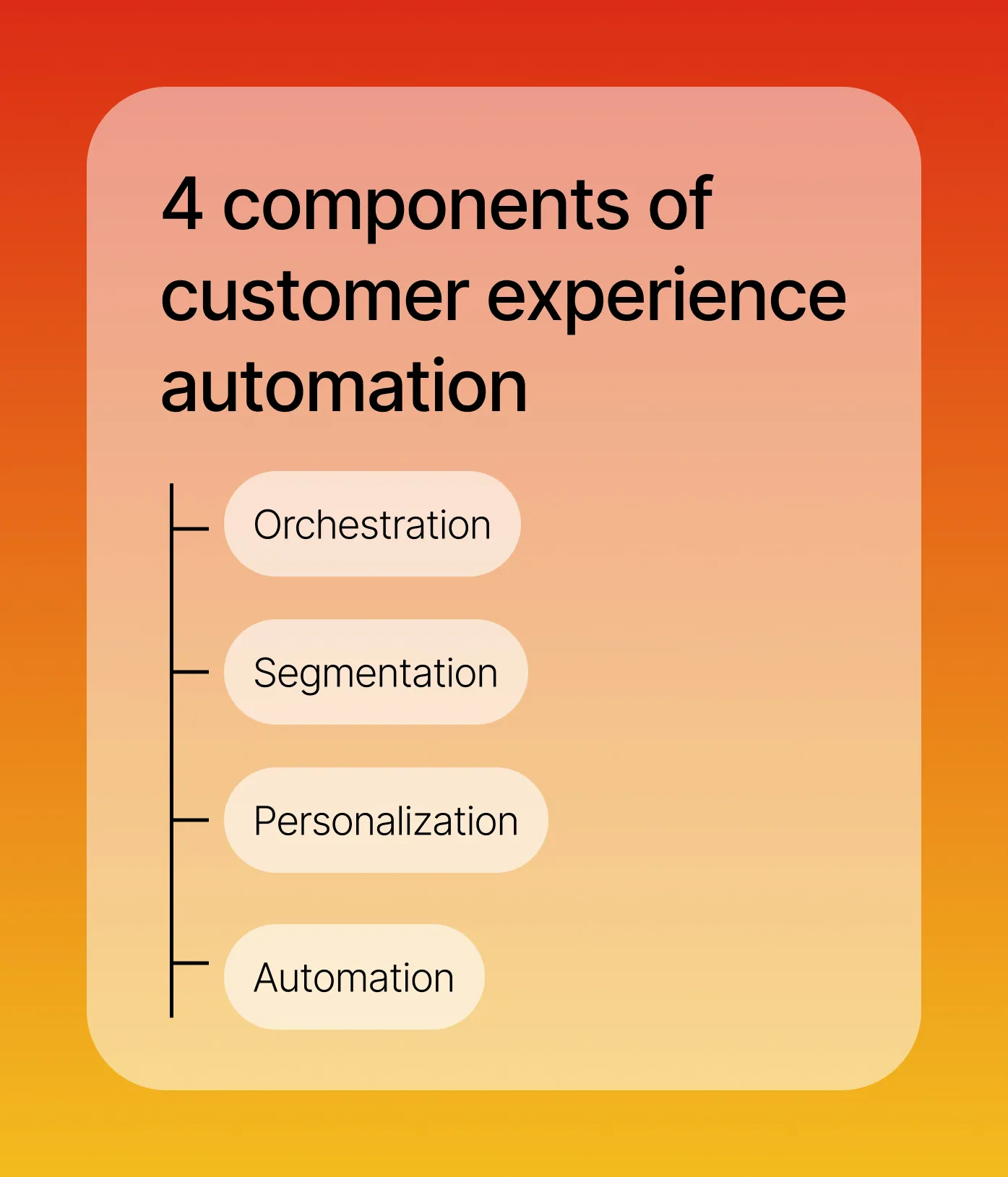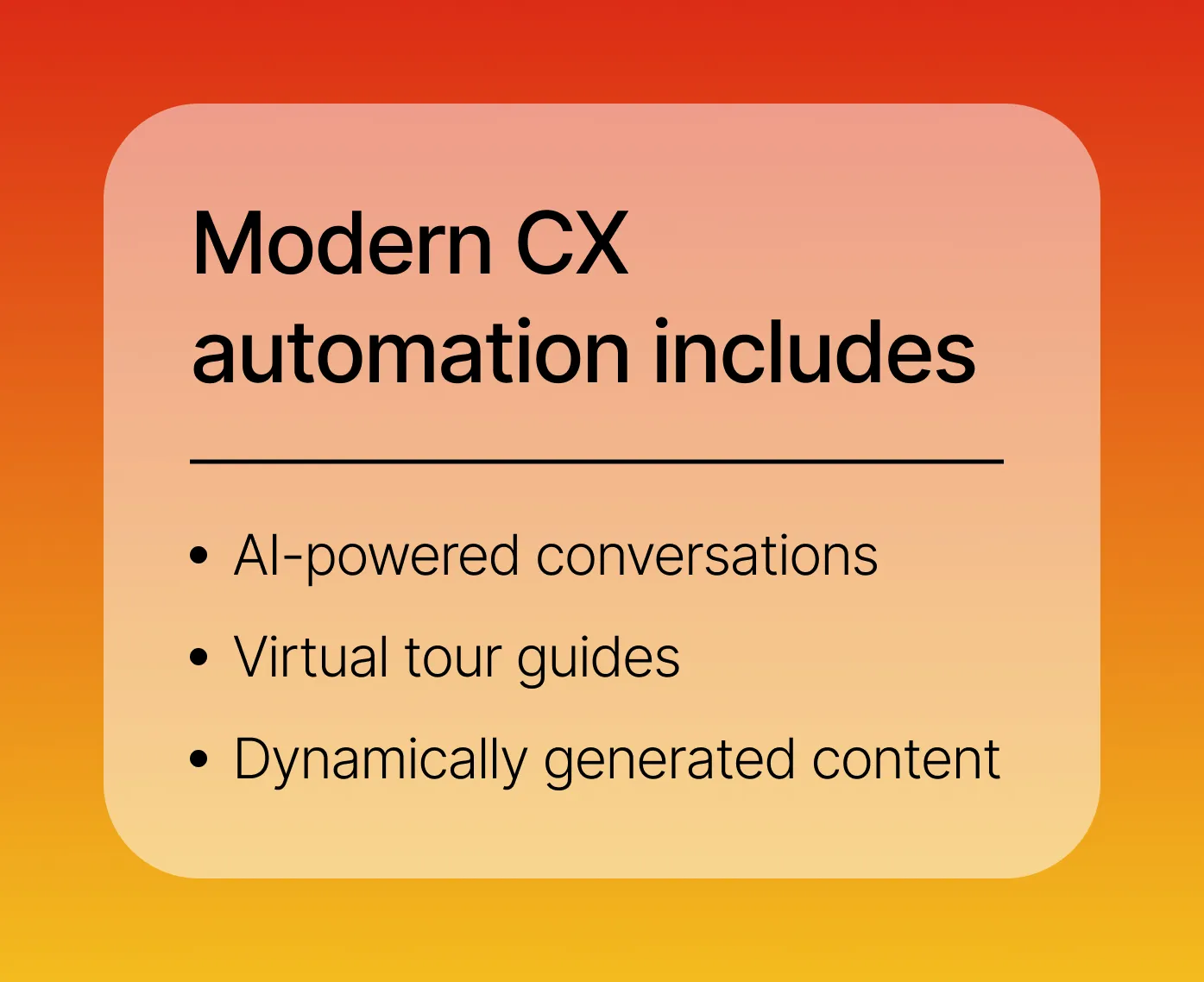Imagine being able to fine tune your users’ experiences in real time, ensuring they have the exact support they need, the tools to use your platform most efficiently, and all of the other small moments of delight that help you secure their loyalty. And imagine all of this being done by technology, automatically.
That’s what customer experience automation aims to do.
What is customer experience automation?
Customer experience automation streamlines customer interactions, minimizing human involvement and leveraging technology to shape customer interactions in the most efficient way possible. This approach is crucial for scaling customer experiences because it allows teams to rely on automated systems instead of manual efforts.
CX automation can happen across all touchpoints in the user journey. The overall goal is to enhance the overall quality and consistency of the experience from one step to the next. For the purpose of this piece, though, we want to focus on leveraging automation to enhance the in-product experience.
This is an especially valuable investment to make for SaaS companies since the digital nature of the products introduces countless opportunities for digital interactions that can enhance the experience. While customer experience automation is used in non-tech sectors as well, SaaS is perhaps the industry that’s most ripe to benefit from these strategies.
There are 4 key components

Orchestration involves mapping out all of the different touchpoints in the customer journey and identifying areas where automation is helpful or necessary. The goal is to create a really natural flow for your user.
Segmentation helps businesses categorize their audience into distinct groups based on a handful of shared traits like demographics, shopping behaviors, budget, and personal values. You can then use these segments to deliver relevant and timely content.
Personalization is about making each customer feel recognized and valued during their interactions with your brand. The segments you established come into play here, as well as other one-to-one personalizations that we’ll touch on later in this piece.
Automation is where it all comes together. You identify opportunities where you can leverage technology to shift tasks off of your team’s plates and scale your efforts.
The traditional CX automation methods
Customer experience automation isn’t anything totally new. Businesses have been leveraging technology to create better experiences for the past decade or so. Typically, CX automation has fallen into one of the three following categories.
Chatbots
Chatbots give users AI-driven conversation-like experiences that are meant to mimic talking with a real human. The goal is to provide immediate, real-time support to your users. Technology like this helps to reduce response times, cuts down on calls that go through to your live support team, and hopefully lead to a more positive customer experience since users are able to get answers quicker.
However, the chatbots of the past (and many of the current chatbots) often face a lot of resistance because they often fall short of really feeling “human” and don’t allow users to talk how they would normally talk, instead forcing them to try to carefully craft their messages in order to be understood.
Although many people like the idea and convenience of chatbots, because of the typical downfalls of the bots, 80% of people prefer to only use them for basic tasks.
Automated emails
Email is one of those things that seems like it will never go away. Despite being popular since the late 1990’s, it still stands as one extremely important component of any customer experience strategy.
This form of automation involves sending emails to customers based on specific triggers or actions they have taken. They can be used in a wide range of scenarios, such as welcoming new customers, confirming orders, or re-engaging those who haven't interacted with the brand in a while.
Surveys
While surveys don’t contribute to shaping the customer experience in real time, they do give you an opportunity to automatically gather information on how to improve the experience and help to close the feedback loop. Many businesses bake in surveys at different points of the experience to understand what moments in the experience may be suffering.
In recent years, there have been some advancements in survey technology that leverage AI to dig deeper into customers’ perceptions, like Worthix’s conversational AI feedback platform.
But you can do better than that in 2024
The traditional customer experience automation solutions are all well and good, but the technology that we have available to us today can help you take the next step and be more sophisticated in your CX automation strategy.
The true goal should be to create a more dynamic experience in your product, catering to the exact user that’s on your platform at that moment.

Real-time conversations without the real-time humans
We’ve already talked about the downsides of traditional chatbots, with an emphasis on the bot. Although the traditional chatbots we’ve been forced to deal with over the last decade or so lack the humanity and understanding we need, it’s beginning to change.
Now, there are AI support agents like Command AI’s Copilot that deliver experiences that feel more like a conversation. Essentially, this new era of technology helps you scale your support operations by letting your users talk to these “agents” just as they would a real person.
Let’s say your user has a question about how to toggle on a specific setting. They’re able to ask the AI agent a question in their own words and get an immediate response. You can also give them the option to toggle that setting on right from the chat, without having to navigate away from the page they’re currently on.
Not only does this offer the speed and convenience of traditional chatbots, but you’re able to provide genuinely helpful support without needing to get any human support teams involved. Any questions or stumbling points that have the potential to disrupt the experience can be nipped in the bud with a simple conversation.
Virtual tour guides
Confusion is one of the quickest ways to sabotage your customer experience, so using automation to shorten or eliminate learning curves is one of the best ways to optimize your CX.
Integrating virtual “guides” in your product can walk your users through any sticky points in the experience. With things like hotspots, non-intrusive pops, checklists, and other interactive tour functionalities, SaaS companies can use tools like Command AI to make it easy for their users to become power users.
You can use data, whether from within your platform or by integrating with other tools, to take advantage of predictive personalization. By leveraging segmentation, past behavior, preferences, and previous interactions, you can anticipate any specific points where a user may need a helping hand and meet them there with personalized suggestions or solutions.
Dynamic content creation
Ease of use is one of the biggest indicators of success for a SaaS platform. In a recent study, 97% of respondents said that ease of use was the most important quality that they looked for when picking and sticking with an app.
Generative AI presents a huge opportunity to essentially do some of the brunt work for your users, making it easier for them to get the most out of your platform.
While many people may use generative AI in their platform to help with tasks like writing copy or generating graphics, predictive analytics is arguably one of the most valuable tools. For example, Tableau’s new Pulse feature automatically generates reports and predictive analytics for their users that are personalized to an exact user.
Think of how something like this could impact the experience for a marketing manager. Instead of them having to set up all of their own dashboards and play around with it to uncover good insights to guide their marketing strategy, generative AI can take some of this work off their plate by offering up insights on a platter every time they hop into the platform.
Customer experience automation should advance as technology does
The bar for innovation is constantly getting pushed higher, so it takes an intentional commitment to keeping up with the new possibilities in tech to stay a step ahead of the competitors out there.
While the customer experience automation solutions that have been in place for the majority of the last decade are still valuable, you need to go beyond. Embracing new technology, especially in the growing AI sector, can help you transform ordinary interactions into memorable experiences that get your users deeply invested in your platform and keep them with you for years to come.

















